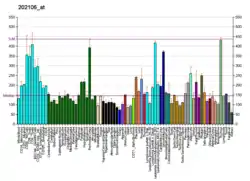GOLGA3
Golgin subfamily A member 3 is a protein that in humans is encoded by the GOLGA3 gene.[5][6][7]
| GOLGA3 | |||||||||||||||||||||||||||||||||||||||||||||||||||
|---|---|---|---|---|---|---|---|---|---|---|---|---|---|---|---|---|---|---|---|---|---|---|---|---|---|---|---|---|---|---|---|---|---|---|---|---|---|---|---|---|---|---|---|---|---|---|---|---|---|---|---|
| Identifiers | |||||||||||||||||||||||||||||||||||||||||||||||||||
| Aliases | GOLGA3, GCP170, MEA-2, golgin A3, Golgin 160 | ||||||||||||||||||||||||||||||||||||||||||||||||||
| External IDs | OMIM: 602581 MGI: 96958 HomoloGene: 4308 GeneCards: GOLGA3 | ||||||||||||||||||||||||||||||||||||||||||||||||||
| |||||||||||||||||||||||||||||||||||||||||||||||||||
| |||||||||||||||||||||||||||||||||||||||||||||||||||
| |||||||||||||||||||||||||||||||||||||||||||||||||||
| |||||||||||||||||||||||||||||||||||||||||||||||||||
| |||||||||||||||||||||||||||||||||||||||||||||||||||
| Wikidata | |||||||||||||||||||||||||||||||||||||||||||||||||||
| |||||||||||||||||||||||||||||||||||||||||||||||||||
The Golgi apparatus, which participates in glycosylation and transport of proteins and lipids in the secretory pathway, consists of a series of stacked cisternae (flattened membrane sacs). Interactions between the Golgi and microtubules are thought to be important for the reorganization of the Golgi after it fragments during mitosis.
This gene encodes a member of the golgin family of proteins which are localized to the Golgi. Its encoded protein has been postulated to play a role in nuclear transport and Golgi apparatus localization. Several alternatively spliced transcript variants of this gene have been described, but the full-length nature of these variants has not been determined.[7]
References
- GRCh38: Ensembl release 89: ENSG00000090615 - Ensembl, May 2017
- GRCm38: Ensembl release 89: ENSMUSG00000029502 - Ensembl, May 2017
- "Human PubMed Reference:". National Center for Biotechnology Information, U.S. National Library of Medicine.
- "Mouse PubMed Reference:". National Center for Biotechnology Information, U.S. National Library of Medicine.
- Fritzler MJ, Hamel JC, Ochs RL, Chan EK (Jul 1993). "Molecular characterization of two human autoantigens: unique cDNAs encoding 95- and 160-kD proteins of a putative family in the Golgi complex". J Exp Med. 178 (1): 49–62. doi:10.1084/jem.178.1.49. PMC 2191081. PMID 8315394.
- Maag RS, Mancini M, Rosen A, Machamer CE (Jun 2005). "Caspase-resistant Golgin-160 Disrupts Apoptosis Induced by Secretory Pathway Stress and Ligation of Death Receptors". Mol Biol Cell. 16 (6): 3019–27. doi:10.1091/mbc.E04-11-0971. PMC 1142444. PMID 15829563.
- "Entrez Gene: GOLGA3 golgi autoantigen, golgin subfamily a, 3".
Further reading
- Bonaldo MF, Lennon G, Soares MB (1997). "Normalization and subtraction: two approaches to facilitate gene discovery". Genome Res. 6 (9): 791–806. doi:10.1101/gr.6.9.791. PMID 8889548.
- Misumi Y, Sohda M, Yano A, et al. (1997). "Molecular characterization of GCP170, a 170-kDa protein associated with the cytoplasmic face of the Golgi membrane". J. Biol. Chem. 272 (38): 23851–8. doi:10.1074/jbc.272.38.23851. PMID 9295333.
- Barr FA (1999). "A novel Rab6-interacting domain defines a family of Golgi-targeted coiled-coil proteins". Curr. Biol. 9 (7): 381–4. doi:10.1016/S0960-9822(99)80167-5. PMID 10209123. S2CID 14404566.
- Dias Neto E, Correa RG, Verjovski-Almeida S, et al. (2000). "Shotgun sequencing of the human transcriptome with ORF expressed sequence tags". Proc. Natl. Acad. Sci. U.S.A. 97 (7): 3491–6. Bibcode:2000PNAS...97.3491D. doi:10.1073/pnas.97.7.3491. PMC 16267. PMID 10737800.
- Mancini M, Machamer CE, Roy S, et al. (2000). "Caspase-2 Is Localized at the Golgi Complex and Cleaves Golgin-160 during Apoptosis". J. Cell Biol. 149 (3): 603–12. doi:10.1083/jcb.149.3.603. PMC 2174848. PMID 10791974.
- Bray JD, Chennathukuzhi VM, Hecht NB (2002). "Identification and characterization of cDNAs encoding four novel proteins that interact with translin associated factor-X". Genomics. 79 (6): 799–808. doi:10.1006/geno.2002.6779. PMID 12036294.
- Hicks SW, Machamer CE (2002). "The NH2-terminal domain of Golgin-160 contains both Golgi and nuclear targeting information". J. Biol. Chem. 277 (39): 35833–9. doi:10.1074/jbc.M206280200. PMID 12130652.
- Strausberg RL, Feingold EA, Grouse LH, et al. (2003). "Generation and initial analysis of more than 15,000 full-length human and mouse cDNA sequences". Proc. Natl. Acad. Sci. U.S.A. 99 (26): 16899–903. Bibcode:2002PNAS...9916899M. doi:10.1073/pnas.242603899. PMC 139241. PMID 12477932.
- Ohta E, Misumi Y, Sohda M, et al. (2004). "Identification and characterization of GCP16, a novel acylated Golgi protein that interacts with GCP170". J. Biol. Chem. 278 (51): 51957–67. doi:10.1074/jbc.M310014200. PMID 14522980.
- Ota T, Suzuki Y, Nishikawa T, et al. (2004). "Complete sequencing and characterization of 21,243 full-length human cDNAs". Nat. Genet. 36 (1): 40–5. doi:10.1038/ng1285. PMID 14702039.
- Gerhard DS, Wagner L, Feingold EA, et al. (2004). "The Status, Quality, and Expansion of the NIH Full-Length cDNA Project: The Mammalian Gene Collection (MGC)". Genome Res. 14 (10B): 2121–7. doi:10.1101/gr.2596504. PMC 528928. PMID 15489334.
- Hicks SW, Machamer CE (2005). "Isoform-specific interaction of golgin-160 with the Golgi-associated protein PIST". J. Biol. Chem. 280 (32): 28944–51. doi:10.1074/jbc.M504937200. PMID 15951434.
- Oh JH, Yang JO, Hahn Y, et al. (2006). "Transcriptome analysis of human gastric cancer". Mamm. Genome. 16 (12): 942–54. doi:10.1007/s00335-005-0075-2. PMID 16341674. S2CID 69278.
- Sbodio JI, Hicks SW, Simon D, Machamer CE (2006). "GCP60 preferentially interacts with a caspase-generated golgin-160 fragment". J. Biol. Chem. 281 (38): 27924–31. doi:10.1074/jbc.M603276200. PMID 16870622.
- Olsen JV, Blagoev B, Gnad F, et al. (2006). "Global, in vivo, and site-specific phosphorylation dynamics in signaling networks". Cell. 127 (3): 635–48. doi:10.1016/j.cell.2006.09.026. PMID 17081983. S2CID 7827573.
- Hicks SW, Horn TA, McCaffery JM, et al. (2007). "Golgin-160 promotes cell surface expression of the beta-1 adrenergic receptor". Traffic. 7 (12): 1666–77. doi:10.1111/j.1600-0854.2006.00504.x. PMID 17118120. S2CID 6554179.
- Sbodio JI, Machamer CE (2007). "Identification of a redox-sensitive cysteine in GCP60 that regulates its interaction with golgin-160". J. Biol. Chem. 282 (41): 29874–81. doi:10.1074/jbc.M705794200. PMID 17711851.




